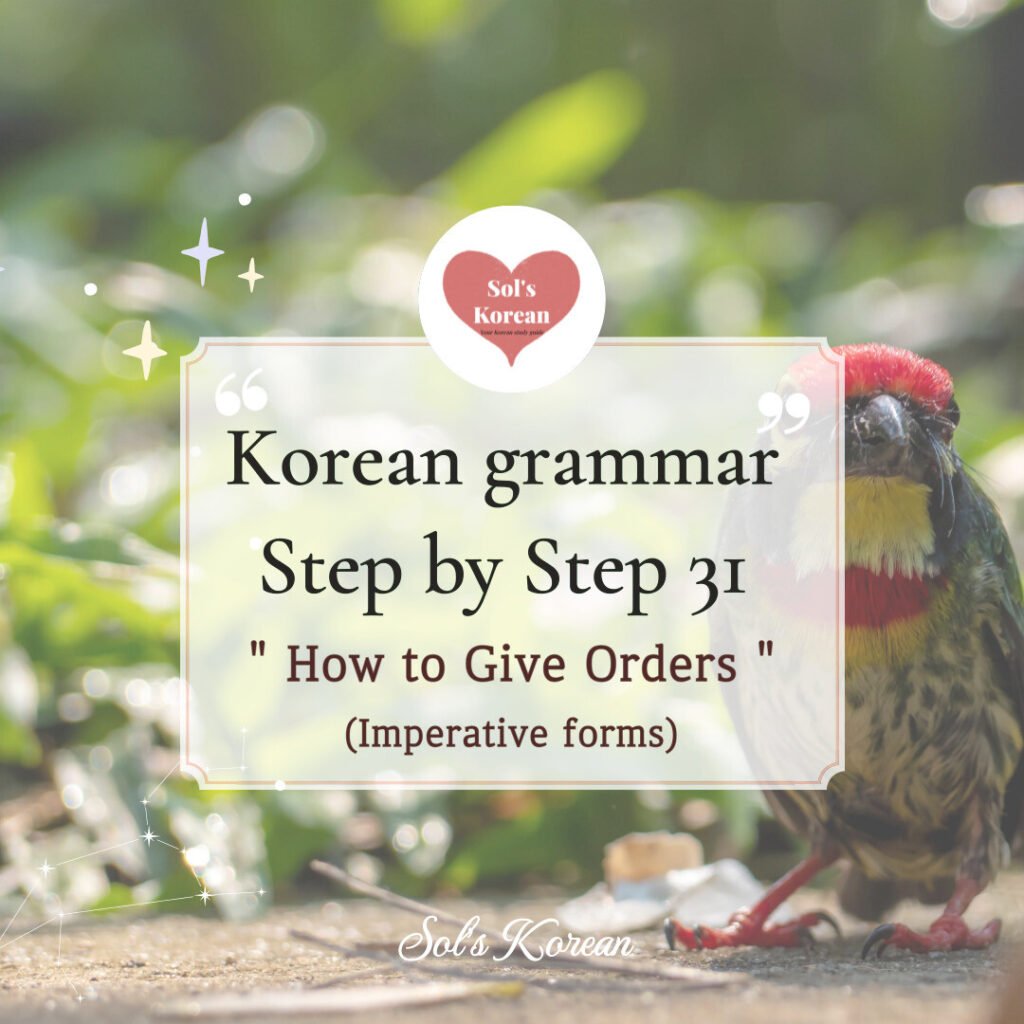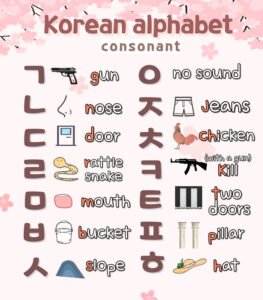How to Give Orders in Korean 십시오/지 마
Hello! Today, we’re going to learn how to order in Korean! there are different ways to give commands and requests, depending on the level of formality, politeness, and the situation.
From the present tense form to -아/어라, -세요, -십시오, and -지 마 grammar, we’ll cover it all!
Here’s a comprehensive guide to expressing imperatives naturally in Korean~
Let’s grasp the concept of grammar
1. Casual Imperative: -아/어/해 (Simple present tense)! (Informal Commands)
This is the most common and natural way to give commands in casual situations with friends, family, or younger people. It sounds friendly but can be rude if used with elders or superiors.
Simply conjugate the verb to the present tense and drop the “요” at the end.
Examples:
빨리 와! → Come quickly!
문 열어! → Open the door!
숙제 해! → Do your homework!
조용히 해! → Be quiet!
밥 먹어! → Eat your food!
✅ Usage:
✔ Talking to close friends, younger siblings, or children.
✔ Sounds natural and common in daily conversation. ✖ Do not use with elders or in formal situations.
If you want to sound more polite while giving a command, you can keep the “요.” Depending on your tone, the listener can distinguish whether you’re giving an order or simply making a statement.
빨리 와요! → Come quickly! (more polite than 빨리 와)
문 열어요! → Open the door!
숙제 해요! → Do your homework!
조용히 해요! → Be quiet!
밥 먹어요! → Eat your food!
✅ Usage:
✔ Talking to strangers, acquaintances, teachers, or older people.
✔ Sounds polite but not overly formal.
✖ Not suitable for very formal situations.
2. Polite Command: -(으)세요 (Respectful and Commonly Used)
* You can refer to my lesson #15 *
The -(으)세요 form is one of the most commonly used imperative forms in Korean. It is both polite and respectful, making it appropriate for most everyday situations. This form is used when speaking to strangers, teachers, older people, or in polite conversations.
How to form🌱
Verb stem ending in a batchim → -으세요
Verb stem ending in a vowel → –세요
Examples:
도와 주세요. → Please help me.
천천히 드세요. → Please eat slowly.
이쪽으로 오세요. → Please come this way.
주의하세요. → Please be careful.
사진 찍어 주세요. → Please take a picture for me.
✅ Usage:
✔ Speaking to elders, teachers, customers, or strangers.
✔ Everyday polite conversations.
✖ Sounds too formal when speaking with close friends or younger people.
3. Formal Imperative: -(으)십시오 (Very Polite and Formal)
This is the most formal and respectful way to give a command. It is mainly used in official announcements, business settings, and public signs.
How to form🌱
Verb stem ending in a batchim → -으십시오
Verb stem ending in a vowel → -십시오
Examples:
앉으십시오. → Please sit down.
들어오십시오. → Please come in.
문을 여십시오. → Please open the door.
주의하십시오. → Please be careful.
✅ Usage:
✔ Business settings, announcements, and public signs.
✔ Formal speeches or addressing customers.
✖ Sounds too formal for casual conversations.
4. Extra) -(으)라
The -아/어라 form is mostly used by older people, like parents or grandparents, when giving commands to younger people. It has a similar level of formality to -아/어, but sounds more old-fashioned or authoritative.
In modern speech, -아/어 sounds much more natural in casual situations.
How to form🌱
Verb stem ending in a batchim → -으라
Verb stem ending in a vowel → –라
Examples:
책을 읽으라. → Read the book.
앞으로 나아가라! → Move forward!
조용히 하라! → Be quiet!
숙제를 하라. → Do your homework.
This form sounds like something an old king would have used, so you don’t really need to pay much attention to it. However, if you want to use indirect speech (e.g., “My mom told me to do my homework”), you’ll need to use the -라 ending. Other than that, I don’t recommend using this imperative form in daily conversation!
5. Prohibitive Commands: -지 마! / -지 마세요! / – 지 말자! (Telling Someone NOT to Do Something)
If you want to tell someone NOT to do something, use -지 마 (casual) or -지 마세요 (polite).
How to form🌱
Verb stem + -지 마 (casual) ✖️ no conjugation needed
Verb stem + -지 마세요 (polite)
👉 “Let’s not (do something)” “-지 말자”
Examples:
가지 마! → Don’t go!
울지 마! → Don’t cry!
만지지 마! → Don’t touch it!
걱정하지 마세요. → Please don’t worry. (지 마 + (으)세요, more polite)
늦지 마세요. → Please don’t be late.
그 얘기는 하지 말자. → Let’s not talk about that.
너무 걱정하지 말자. → Let’s not worry too much.
싸우지 말자. → Let’s not fight.
여기에서 사진 찍지 말자. → Let’s not take pictures here.
✅ Usage:
✔ Casual (-지 마) for friends, younger people.
✔ Polite (-지 마세요) for formal situations.
Extra✨
Suggestion : – 자 and – 아/어/해 보다
Let’s Do Something: -자! (Suggestive Commands)
If you want to suggest doing something together, use -자.
How to form🌱
Verb stem + -자
✖️ no conjugation needed
Examples:
가지 마! → Don’t go!
밥 먹자! → Let’s eat!
영화 보자! → Let’s watch a movie!
내일 만나자! → Let’s meet tomorrow!
빨리 가자! → Let’s go quickly!
Suggesting Someone Try Something: -아/어 보다
The -아/어 보다 form is used to suggest that someone try something or give something a go.
How to form🌱
Conjugated verb + 보다(present tense)
Examples:
이 케이크 한번 먹어 봐. → Try eating this cake.
이 옷을 입어 보세요. → Try wearing this outfit. (polite)
여기에 가 봐. → Try going here.
한국어로 말해 보세요. → Try speaking in Korean. (polite)

🌼Come visit my Youtube Channel 🌼
Check out useful Korean expressions!☕
Check out Korean listening materials👂🎧







